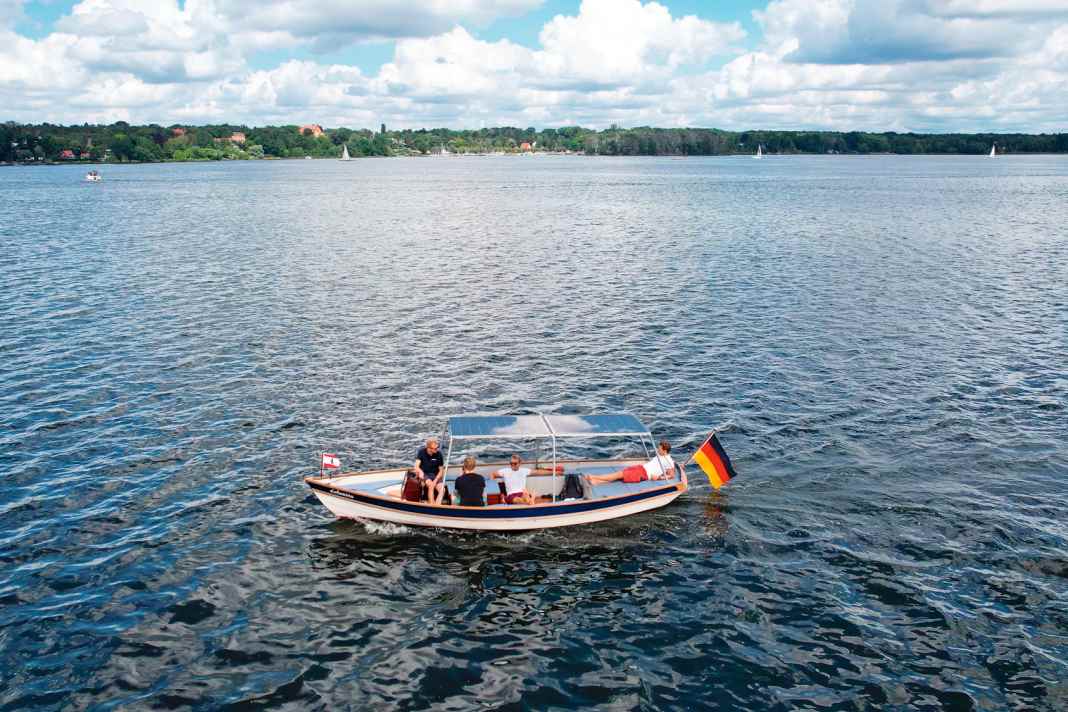





It's Friday afternoon. The sun is shining on Berlin, giving hope for a sunny weekend. The "d'Ampère" moves quietly through the murky Wannsee water. We savour the silence. The special thing about this day is the drive.
The shipyard Alveus Bootsbau from Potsdam presents its electrical project to us. We were allowed to test the approximately 6.6 metre long boat, a Drascombe from England. The Alveus shipyard bought the old hull and restored it. The idea behind this, as the two young shipyard owners explain, is not always to buy everything new. It is possible to refit existing boats so that they are in no way inferior to a new boat.
It is also important to both of them to use as few new resources as possible. Always with the environment in mind. It doesn't always have to be a combustion engine. An electric outboard motor is a good alternative for this type of boat; the only thing that needs to be ensured is that the batteries can be recharged. The two young boat builders Hilmar Dembler-Malik and Fritz Müller can impressively demonstrate that they have succeeded in this conversion.
There is nothing wrong with the quality of the restoration, the boat is from 1992 and looks like new. Whether it is the new construction of wooden parts such as the rubbing strake or the battery box, the overhaul of the gelcoat or the refurbishment of the old fittings, everything shines and flashes, better than new.
Top feature: The special drive
The extraordinary thing about this boat, however, is the drive: a Torqeedo Cruise 2.0. This small 24-volt electric motor with 2 kW drive power accelerates the boat to a maximum of 6.5 knots. No outboard rattling, no exhaust fumes. Just the sound of the small waves lapping against the bow and the quiet, monotonous hum of the electric outboard. The 260 ampere-hour batteries are charged using solar panels mounted on the bimini top. In optimum conditions, these achieve a maximum charging capacity of 700 watts and can therefore charge the boat independently.
At the cruising speed of 4.5 knots specified by the shipyard, the range is given as approximately 30 nm plus 16 per cent reserve. During our test, which lasted around three hours, the battery lost almost none of its charge. We were able to dock the boat with the same battery voltage with which we had also docked it.
As the steering position is unusually installed in the bow area of the boat, it feels unfamiliar for the first few metres. However, this quickly subsides after the first few minutes and we are travelling at 5 knots across the Wannsee. It's not fast, but it's enough to spend a cosy and relaxed day on the water - it doesn't always have to be a speedy trip. The silence and the knowledge that we hardly have to worry about charging the batteries - they are charged by the sun - are wonderfully reassuring.
And what about more power?
When asked whether it would be possible to equip the boat with more kW, boat builder and co-founder of the shipyard Hilmar Dembler-Malek nods and replies: "That is possible, but we first wanted to see whether it would work at all, which is what we had in mind." In our opinion, it is not absolutely necessary. The hull speed we calculated is around 6 knots, which the boat already achieves with the Torqeedo Cruise 2.0 drive. For higher speeds, the boat would have to start planing, which is not possible anyway due to its design.
Special attention is paid to the bimini construction. The aluminium tube structure supports the two solar modules. These are partially transparent, so there is a pleasant shade in the boat, but there is no oppressive feeling.
There was no simple solution to attach the bracket to the boat that could be bought. The feet had to be adjustable and thus adapt to the deck. It therefore made sense to design something suitable themselves. The two boat builders quickly turned to the 3D printer. They made a drawing and thought about how it could best be realised. A neighbour in the business park was able to help and then print the design. And cosiness was also taken care of. The seats are covered with self-made fabric cushions and underline the image of a cosy day cruiser for calm waters.
Conclusion
After our first impression and a few metres of sailing, we can say that the project has been a success. The boat looks good and - most importantly - it works well. If you are looking for something for lakes or calm waters, you have found a good alternative to the classic boats with combustion engines. However, in our opinion it is only intended for lakes. It would be out of place on open water.
Technical data
The boat
- Type:Drascombe Boats
- Length over everything:6,63 m
- Waterline length: 5,50 m
- Width: 2,00 m
- Weight (o. M.): 600 kg
- Year of construction: 1992
- Fuel type: Electrical
- Motorisation: Outboard motor 2.0 kW
- Battery capacity: 260 AH at 24 volts
- Refit shipyard: Alveus boatbuilding
The motor
- Manufacturer: Torqeedo
- Type: Cruise 2.0
- Performance: 2.0 kW
- Fuel: Electrical
- Charging: Solar modules

